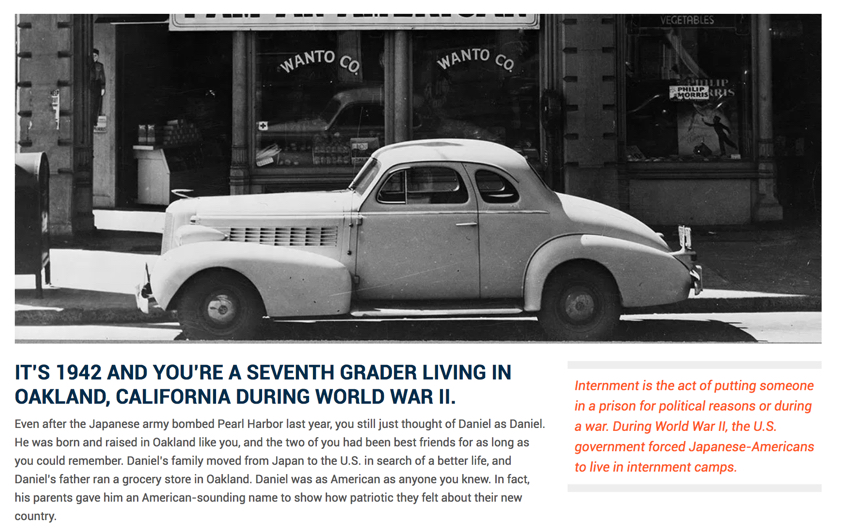Library of Congress Adds Awesome New Tools. Today? Case Maker.
A year or so ago, the Library of Congress introduced three new apps that focused on civics and the use of primary sources. Eagle Eye Citizen, Engaging Congress and Kid Citizen were developed through the LOC’s Teaching with Primary Sources (TPS) program.
All three are awesome. And the Library could have smugly sat back in its La-Z-Boy and called it good. But they didn’t. They went out, grabbed the folks from iCivics and Bean Creative, and developed two new apps that build civic and historical thinking skills in your students.
Lee Ann Potter, director of the Educational Outreach division at the Library of Congress:
The two latest apps, Case Maker and DBQuest, provide opportunities for students to investigate complex questions from some of the most dramatic turning points in U.S. history and immerse them in conversations around those events.
Today, we’ll dig into Case Maker. Tomorrow, DBQuest.
Case Maker is a customizable system for inquiry-based learning for students using primary sources from the Library of Congress. The web-based tool guides students on how to challenge a question, collect evidence, and make a case under the “observe, reflect, question” framework developed by the Teaching with Primary Sources program.
Case Maker is a collection of 20 pre-made challenges designed for 6th through 8th grade civics education projects. Each of the ready made challenges as well as any that you customize, has a unique share code that you can give to students, so that they can review the challenge and make their own personal case on the topic.
Tools and ideas to transform education. Sign up below.

How would teachers use it?
The 20 pre-made civics education challenges are ready to be used in a classroom immediately. Each Challenge has a Challenge Code to make it simple to share with your students.
From there, students review the challenge, add annotations to the related primary source documents, and build a series of case folders.
When done, students use the Case Maker presentation mode to show off their work or use it as a reference for other projects.
Teachers who want to offer something more unique or specialized to their students can create a free Case Maker account and customize any available Challenge by changing the text and the associated primary sources.
[5 Handy Tools that Combat Fake News and Create Informed Citizens]

Once done, you share your custom challenges via a unique code, exactly the way pre-made Challenges are shared.
With your account, you can also follow up on student progress by opening a non-editable presentation view of any of the Cases made using the custom Challenge Codes.
What kinds of things are students doing?
Challenges feature a descriptive story layer that sets the scene and encourages students to ask tough questions about meaning, author perspective, omitted facts, and unanswered questions. Each challenge is what Case Maker calls a story-driven mystery or question that engages students in a scenario that blends historical fact and current events.
To get to a challenge, your kids go to the Case Maker site and enter the code you provided.
Once they have reviewed the challenge, students investigate related primary source documents, then make their case based on what they have seen, heard, read, considered, and felt.

Each student’s case is comprised of a series of folders where they can collect annotations – made by examining primary sources then choosing which pieces are relevant to their argument. They can move annotated source documents into different folders to organize their case.
Finally, when they’re done, students can either use the case they’ve created as a reference for any sort of assignment (paper, talk, debate, etc.), or they can use Case Maker’s ready-made presentation mode to show off their work directly.
I like the concept. Asking kids to examine evidence and create claims using that evidence is always a good thing. And the 20 pre-made challenges focus on some great topics. I especially like the ability to adapt the challenges.
You’re able to tweak the prompts and guiding questions to focus on specific contemporary issues. The problem I have? You can add and subtract primary sources but you’re limited to a list of sources that Case Maker provides. Unless I missed something, you’re not able to upload any of your own sources or sources from archives other than the Library’s somewhat limited list.
But even with that limitation, CaseMaker is still a nice addition to your instruction – especially if you teach in a one to one environment. (And if your tech is limited, use the prompts, download and print out the primary sources, and go old school.)
cross posted at glennwiebe.org
Glenn Wiebe is an education and technology consultant with 15 years' experience teaching history and social studies. He is a curriculum consultant for ESSDACK, an educational service center in Hutchinson, Kansas, blogs frequently at History Tech and maintains Social Studies Central, a repository of resources targeted at K-12 educators. Visit glennwiebe.org to learn more about his speaking and presentation on education technology, innovative instruction and social studies.
